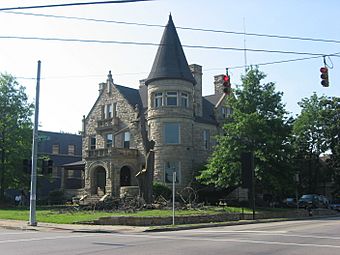Captain Stone House facts for kids
Quick facts for kids |
|
|
Capt. Stone House
|
|

Front of the house
|
|
| Location | 405 Oak St., Cincinnati, Ohio |
|---|---|
| Area | less than one acre |
| Built | 1890 |
| Architect | Samuel Hannaford & Sons |
| Architectural style | Romanesque Revival |
| MPS | Samuel Hannaford and Sons TR in Hamilton County |
| NRHP reference No. | 80003041 |
| Added to NRHP | March 3, 1980 |
The Captain Stone House is a historic building in Cincinnati, Ohio, United States. It was built in 1890 and has a special design style called Romanesque Revival. A famous team of architects, Samuel Hannaford and Sons, designed this house.
The house was built for George N. Stone, a well-known person in Cincinnati. His wife, Martha E. Stone, was a survivor of the sinking of the Titanic. They lived there with their two daughters.
Contents
Who Was Captain Stone?
George N. Stone was born in New Hampshire. He served as an officer in the U.S. Army during the Civil War. After the war ended, Stone moved to Cincinnati. There, he became a very successful businessman.
What Does the House Look Like?
The Captain Stone House is located on a corner lot. It has many unique features. One special part is a round turret (a small tower) at the most visible corner. There is also a large gable (the triangular part of a wall under a sloping roof) on the front of the house.
The house has an unusual shape and is two-and-a-half stories tall. It is made mostly of strong limestone blocks. The foundation, which supports the house, is also made of stone. The roof is made of asbestos.
You can enter the house through a grand Romanesque-style entryway. This entrance is reached by a large front porch.
A Famous Architect's Work
The Captain Stone House shows the typical style of the Hannaford architects. At least four other houses designed by Hannaford from the same time are still in Cincinnati. All five of these buildings have walls made of carefully cut stone blocks.
By the late 1800s, Samuel Hannaford was very famous in Cincinnati and beyond. He had designed the grand Music Hall in the 1870s. Many of the city's wealthiest people asked him to design their homes. These homes were often in the most fancy neighborhoods.
Dozens of Hannaford's designs from the 1800s can still be seen in Cincinnati. This includes about twenty houses. Many of these buildings are considered important enough to be protected as historic sites. Their unique architecture makes them special.
A Historic Landmark
The Captain Stone House is one of these important buildings. It was added to the National Register of Historic Places in 1980. This means it is recognized as a significant historical place. Its architecture is so important that it is valued across the entire state of Ohio. Most of Hannaford's other remaining buildings in Cincinnati are also listed on the National Register.



